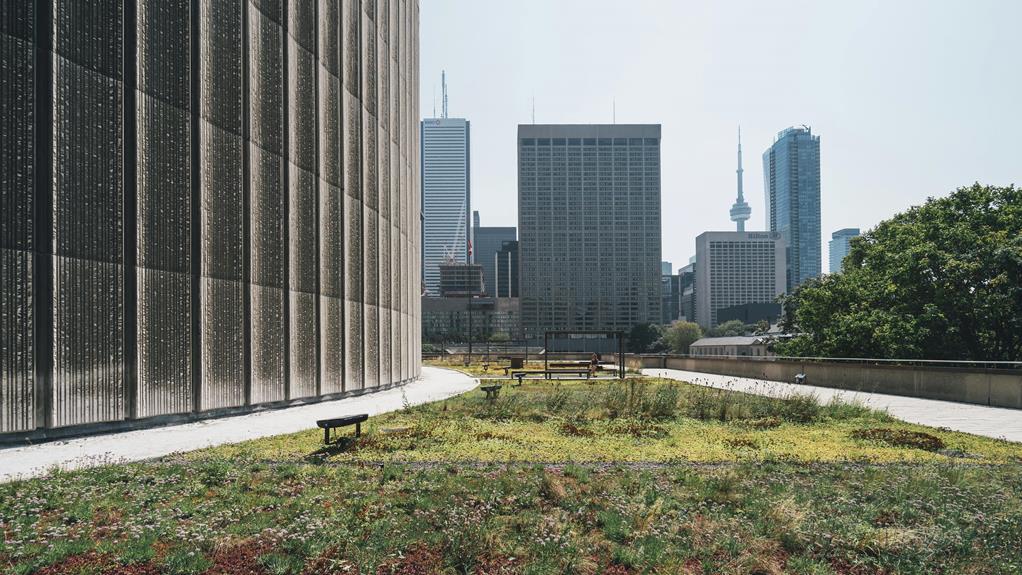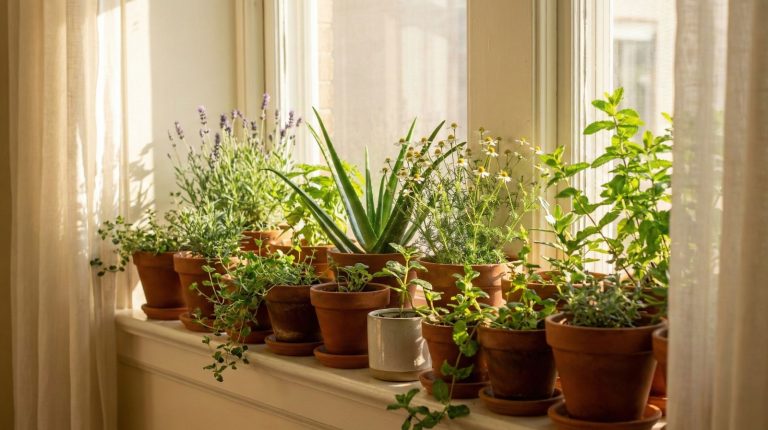Welcome to our journey of unlocking the incredible benefits of sustainable landscaping. As we explore the world of eco-friendly practices, we discover a treasure trove of advantages waiting to be embraced.
From conserving water and improving soil health to promoting biodiversity and enhancing air quality, sustainable landscaping offers a multitude of rewards. Not only does it increase property value and reduce maintenance costs, but it also provides psychological and health benefits.
Join us as we delve into this harmonious blend of nature and belonging.
Water Conservation
We’ll explore the importance of water conservation in sustainable landscaping.
Water conservation plays a vital role in maintaining a sustainable and eco-friendly landscape. By implementing sustainable irrigation techniques, we can minimize water waste and ensure the long-term health of our environment.
One effective technique is the use of drip irrigation systems, which deliver water directly to the roots of plants, reducing evaporation and runoff.
Another method is the installation of rainwater harvesting systems, allowing us to collect and reuse water for irrigation purposes.
Additionally, proper soil management techniques such as mulching and composting can improve water retention, reducing the need for excessive watering.
Ultimately, water conservation not only helps preserve our precious resources but also promotes a sense of belonging to a community that values sustainability and environmental stewardship.
Soil Health Improvement
When it comes to sustainable landscaping, one crucial aspect to consider is soil health improvement. By focusing on nutrient-rich soil regeneration, we can create a thriving ecosystem that supports the growth of healthy plants and trees.
Additionally, implementing erosion prevention techniques helps maintain the integrity of the soil, preventing valuable nutrients from being washed away.
Nutrient-Rich Soil Regeneration
To achieve nutrient-rich soil regeneration in sustainable landscaping, we actively enhance the health of our soil by implementing organic practices. By prioritizing soil fertility and adopting organic farming techniques, we create an environment that supports the growth of healthy plants and promotes biodiversity.
Organic practices such as composting, crop rotation, and cover cropping are integral to our approach. Composting allows us to recycle organic waste and convert it into nutrient-rich soil amendments.
Crop rotation helps prevent soil depletion by alternating the types of crops grown in a specific area, allowing the soil to replenish its nutrients naturally.
Cover cropping involves planting specific plants to protect and enrich the soil during fallow periods.
These organic practices not only improve soil health but also contribute to the overall sustainability and resilience of our landscapes.
Erosion Prevention Techniques
We implement erosion prevention techniques to improve soil health and protect our sustainable landscapes.
Erosion control techniques play a vital role in maintaining the stability and fertility of the soil. By preventing soil erosion, we can preserve the precious topsoil and ensure its ability to support plant growth and water infiltration.
One effective technique is the use of vegetative cover, such as grasses and shrubs, which act as natural barriers against erosion. These plants have extensive root systems that bind the soil particles together, reducing the risk of erosion caused by wind or water.
Additionally, contour plowing and terracing are methods that help slow down the flow of water and prevent it from carrying away soil particles.
Biodiversity Promotion
Promoting biodiversity is essential for sustainable landscaping as it enhances ecosystem health and resilience. By creating pollinator habitats and maintaining ecological balance, we can contribute to the well-being of our environment.
Here are three key reasons why biodiversity promotion is crucial:
- Supporting pollinator habitats: Planting native flowers and providing nesting sites for bees, butterflies, and other pollinators helps ensure the reproduction of plants and the production of fruits and seeds.
- Maintaining ecological balance: A diverse range of plant and animal species in our landscapes helps maintain a balanced ecosystem. Each species plays a unique role in regulating pests, cycling nutrients, and enhancing soil fertility.
- Enhancing resilience: Biodiversity increases the ability of ecosystems to withstand disturbances, such as climate change and disease outbreaks. Resilient landscapes are more adaptable and can recover faster, ensuring a sustainable future for all.
Air Quality Enhancement
Enhancing air quality is a key benefit of sustainable landscaping through the implementation of air-filtering plants and proper maintenance practices. By incorporating these elements into our outdoor spaces, we can improve indoor air quality and provide respiratory health benefits for ourselves and our communities.
Indoor air quality improvement is a crucial aspect of sustainable landscaping. Air-filtering plants, such as ferns, spider plants, and peace lilies, have the ability to remove harmful toxins from the air, such as formaldehyde and benzene. These plants act as natural air purifiers, helping to create a healthier and more vibrant living environment.
In addition to air-filtering plants, proper maintenance practices also play a significant role in enhancing air quality. Regularly cleaning and maintaining outdoor spaces can prevent the accumulation of dust, pollen, and other allergens that can negatively impact respiratory health. By keeping our outdoor areas clean and well-maintained, we can reduce the risk of allergies and respiratory issues.
Energy Efficiency
Implementing energy-efficient practices is another important aspect of sustainable landscaping, reducing our environmental impact and conserving resources. By incorporating energy efficient landscaping techniques, we can create outdoor spaces that aren’t only visually appealing but also environmentally responsible.
Here are three key ways to achieve energy efficiency in landscaping:
- Smart irrigation systems: Installing drip irrigation or using rainwater harvesting systems can significantly reduce water consumption, saving both water and energy.
- Native plant selection: Choosing native plants that are adapted to the local climate and soil conditions can minimize the need for excessive watering, fertilizers, and pesticides, thereby reducing energy consumption.
- Renewable energy integration: Utilizing solar-powered lighting, water features, or even installing solar panels on rooftops can help generate clean energy and reduce reliance on fossil fuels.
Noise Reduction
To achieve noise reduction in sustainable landscaping, we can explore various strategies and techniques. Sound pollution reduction is essential for creating peaceful surroundings that promote a sense of belonging and well-being.
One effective method is to incorporate natural barriers such as trees, shrubs, and hedges, which act as sound absorbers and buffers. These green elements not only reduce noise levels but also enhance the aesthetic appeal of the landscape.
Additionally, using materials with sound-dampening properties, such as permeable pavements and acoustic fences, can further contribute to noise reduction.
Proper placement of outdoor features and structures can also play a crucial role in minimizing unwanted sounds.
Climate Change Mitigation
In addressing climate change mitigation within sustainable landscaping, we can take steps to reduce our carbon footprint and promote environmental sustainability. By incorporating climate change adaptation strategies into our landscaping practices, we can create resilient ecosystems that are better equipped to withstand the impacts of a changing climate.
One way to achieve this is through carbon sequestration, which involves capturing and storing carbon dioxide from the atmosphere. This can be done by planting trees and utilizing green infrastructure, such as green roofs and permeable pavements, which help to absorb carbon emissions.
Additionally, implementing water-wise landscaping techniques can reduce the need for irrigation, conserving water resources and minimizing the energy required for water treatment.
Such measures not only contribute to climate change mitigation but also create a sense of belonging to a community that values and protects the environment.
Increased Property Value
By incorporating climate change adaptation strategies into our landscaping practices, we can also increase the value of our properties. Sustainable landscaping not only benefits the environment but also enhances the curb appeal and aesthetics of our homes. Implementing eco-friendly practices such as using native plants, reducing water consumption, and promoting biodiversity can significantly improve the overall appearance of our landscapes.
Increased curb appeal is a key factor in attracting potential buyers and increasing property value. A well-maintained and visually appealing landscape creates a positive first impression and sets the tone for the entire property. Additionally, sustainable landscaping showcases our commitment to environmental stewardship, which is becoming increasingly important to buyers who desire to belong to a community that values sustainability.
Investing in sustainable landscaping not only benefits the environment but also provides a tangible return on investment in terms of increased property value. So let’s embrace sustainable practices and unlock the full potential of our properties while creating a greener, more beautiful future.
Reduced Maintenance Costs
Maintaining a sustainable landscape can lead to significant reductions in maintenance costs. By implementing eco-friendly practices, such as reducing water usage and enhancing curb appeal, we can’t only create a beautiful outdoor space but also save money in the long run.
Here are some key benefits of sustainable landscaping that can help reduce maintenance costs:
- Reduced water usage:
- Installing native plants that are adapted to the local climate can reduce the need for excessive watering.
- Utilizing efficient irrigation systems, such as drip irrigation or smart controllers, can minimize water waste.
- Enhanced curb appeal:
- Properly maintained landscapes create a positive impression and increase the value of the property.
- Well-designed landscapes with a variety of plants and features require less frequent maintenance.
- Lower maintenance requirements:
- Selecting low-maintenance plants and incorporating mulch can reduce the need for constant pruning, fertilizing, and weeding.
- Using organic fertilizers and natural pest control methods can minimize the use of harmful chemicals.
Psychological and Health Benefits
When it comes to sustainable landscaping, the benefits go beyond just environmental impact.
One of the key advantages is the positive impact on our psychological and physical health. By incorporating nature into our surroundings, we can experience reduced stress levels and improved mental well-being.
The calming effect of green spaces and the connection with the natural world can contribute to a healthier and happier lifestyle.
Stress Reduction Through Nature
Spending time in natural environments provides us with numerous psychological and health benefits, including stress reduction. Nature therapy, also known as ecotherapy, has gained popularity as a way to improve mental well-being and alleviate stress.
Here are three key benefits of spending time in green spaces:
- Improved mood and mental health: Research has shown that being in nature can boost mood, reduce symptoms of anxiety and depression, and improve overall mental well-being. The calming effect of natural surroundings can help reduce stress levels and promote relaxation.
- Enhanced physical health: Being outdoors in green spaces encourages physical activity, which is essential for maintaining a healthy lifestyle. Activities like walking, hiking, or gardening in nature can improve cardiovascular health, strengthen muscles, and increase energy levels.
- Increased resilience to stress: Regular exposure to nature has been linked to an increased ability to cope with stress. Nature provides a sense of peace and tranquility, allowing individuals to disconnect from daily pressures and recharge their mental and emotional batteries.
Improved Mental Well-Being
We experience a range of psychological and health benefits when we incorporate sustainable landscaping into our environments.
Nature therapy, also known as ecotherapy, is a holistic approach that utilizes green spaces to improve mental well-being. Research shows that spending time in nature can reduce stress, anxiety, and depression, and improve overall mood and cognitive function.
Green spaces have a calming effect on our minds, allowing us to escape the hustle and bustle of daily life and find peace and tranquility. The sights, sounds, and smells of nature stimulate our senses and promote relaxation, leading to improved mental health.
Conclusion
Sustainable landscaping offers a multitude of benefits that go beyond just a pretty garden. By conserving water, improving soil health, promoting biodiversity, enhancing air quality, increasing energy efficiency, mitigating climate change, and providing psychological and health benefits, it truly embodies the adage ‘a small act can make a big difference.’
Embracing eco-friendly practices not only improves the environment but also adds value to our properties and reduces maintenance costs. Let’s unlock the full potential of sustainable landscaping for a greener future.




